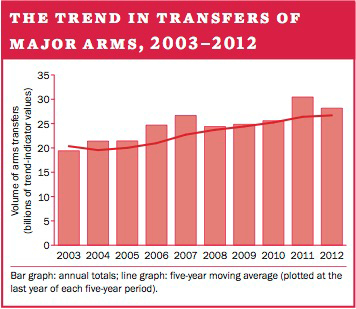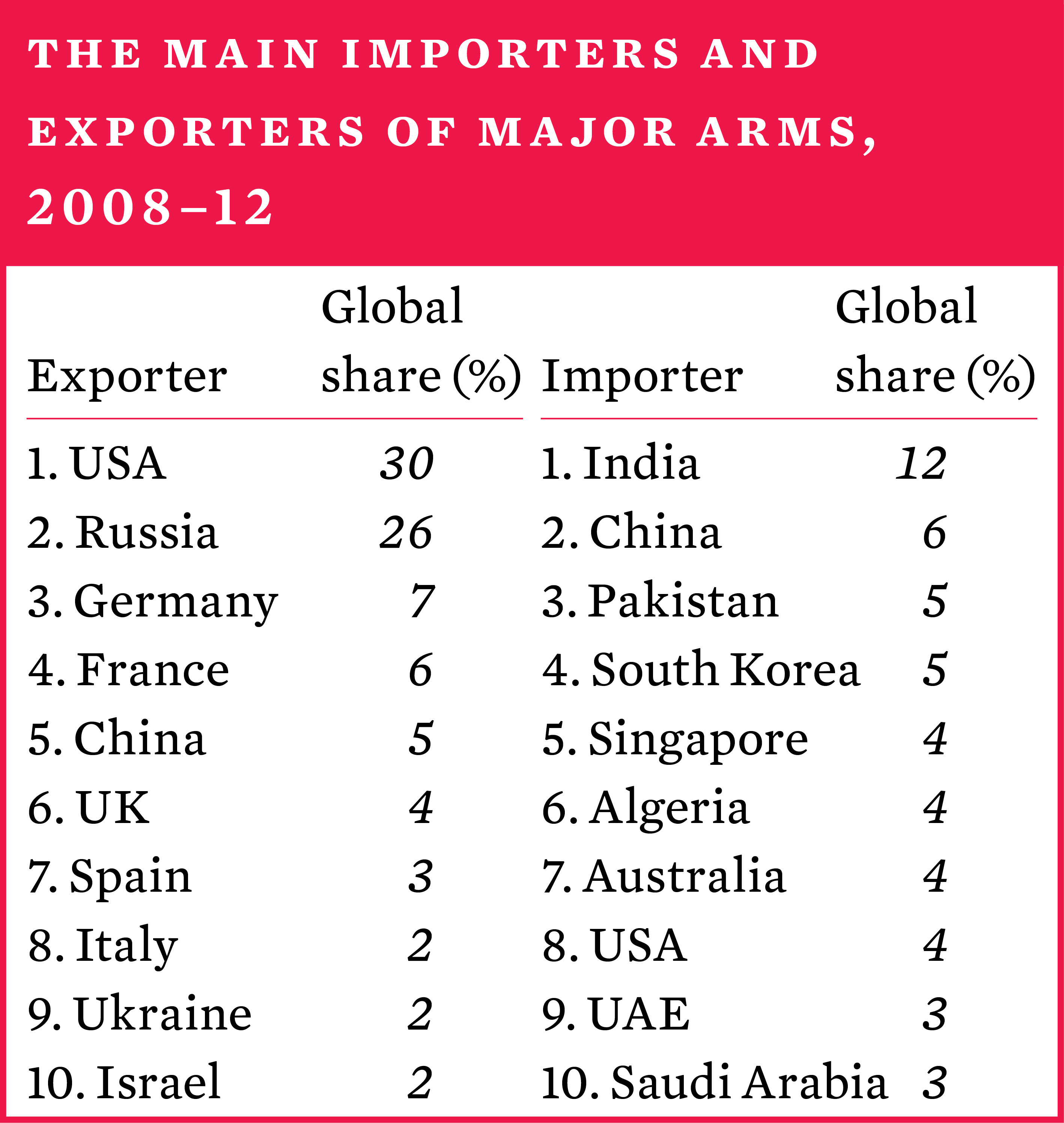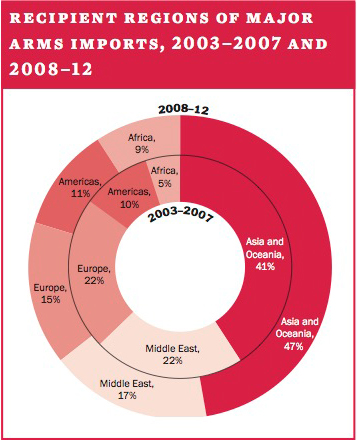5. International arms transfers
- Overview [PDF]
PAUL HOLTOM
- I. Developments in arms transfers, 2012 [PDF]
PAUL HOLTOM, MARK BROMLEY, PIETER D. WEZEMAN AND SIEMON T. WEZEMAN
-
II. Arms transfers to Western and Central Europe [PDF]
MARK BROMLEY
- III. Arms transfers to Syria [PDF]
PIETER D. WEZEMAN
- IV. Transparency in arms transfers [PDF]
PAUL HOLTOM AND MARK BROMLEY
- V. The financial value of states’ arms exports [PDF]
MARK BROMLEY
Summary
The volume of international transfers of major conventional weapons grew by 17 per cent between 2003–2007 and 2008–12. The five largest suppliers in 2008–12—the United States, Russia, Germany, France and China—accounted for 75 per cent of the volume of exports. This is the first time since the end of the cold war that China has ranked among the five largest arms exporters, which had consisted solely of the USA and European states.
China may represent the vanguard of an increase in the significance of Asian suppliers in the international arms trade, as South Korea is an emerging arms supplier and Japan and Singapore have potential to become major suppliers.
Other significant changes in 2008–12 include the absence from the top five suppliers of the United Kingdom for the first five-year period since 1950; the departure of the Netherlands from the 10 largest suppliers; and the ranking of Ukraine as the ninth largest supplier.
One of the consequences of the impact of the financial crisis in the USA and Europe has been the additional pressure to seek new export markets. This has led the USA and European states to streamline bureaucratic procedures and to be more willing to engage in licensed production, technology transfer and cooperative production arrangements.
While SIPRI data on international arms transfers does not represent their financial value, a number of states also publish figures on the financial value of their arms exports. Based on national data, SIPRI estimates that the total value of the global arms trade in 2011 was at least $43 billion.



Arms transfers to Western and Central Europe
The trend in the volume of major conventional weapons imported by states in Western and Central Europe broadly matches recent trends in military spending in the region. Between 2003–2007 and 2008–12, imports in Western Europe fell by 16 per cent and in Central Europe by 49 per cent. In Western Europe the overall fall in imports was largely driven by declines in imports by Greece and Italy, which fell by 61 per cent and 55 per cent, respectively.
Decisions to delay and cancel import contracts appear to be affecting European states’ efforts to boost their own arms exports, which have been stepped up in recent years in order to help offset losses in revenues caused by reduced domestic procurement. The budget cuts of European states may also affect efforts to promote the consolidation of arms production in Europe and the joint development and acquisition of weapon systems.
Transparency in arms transfers
The number of states reporting their arms imports and exports to the United Nations Register of Conventional Arms (UNROCA) decreased from 86 states in 2011 to an all-time low of 52 states in 2012. Africa was the only region that did not record a significant decline in reporting.
An increasing number of governments have published national reports on arms exports. As of January 2013, 35 states had published at least one national report on arms exports since 1990.
Arms transfers to Syria
As the conflict in Syria intensified in 2012, the international community remained at an impasse on how to respond. It could not agree on how to deal with the conflict in general or with supplying arms to the parties in the conflict in particular. Whereas the European Union, the League of Arab States, Turkey and the United States maintained arms embargoes against the Syrian Government, Iran and Russia continued to supply it with arms. Rebel forces called for foreign military aid and neighbouring countries appeared to supply them with arms or provide funds for arms acquisitions.
Since the start of the conflict in 2011 there has been a sharp division between states that oppose the imposition of United Nations sanctions on Syria and that continue to supply arms to the Syrian Government, and states that have imposed arms embargoes on Syria and called for a UN embargo. Russian officials have been most vocal with regard to the former position and made clear statements that arms supplies were continuing in 2011–12.
The main source of weapons for Syrian rebel groups appears to have been the capture of arms from government troops and arsenals. Small arms and light weapons were also obtained on the black market in Iraq and Lebanon. Nevertheless, rebel forces repeatedly called in 2012 for governments supporting their cause to supply them with weapons and other military equipment